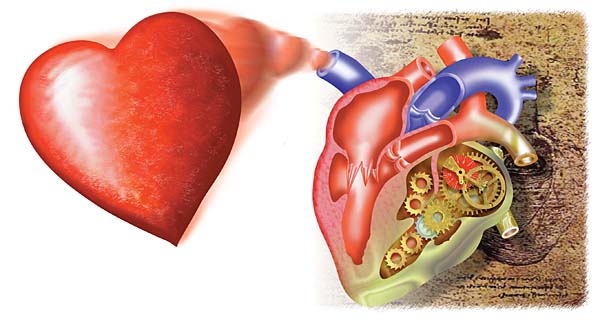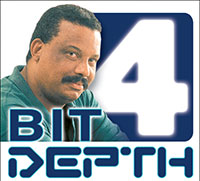BitDepth 482 - July 19
11/01/09 17:43 Filed in: BitDepth - July 2005
Thoughts on learning and creativity in an age of technology
Art in our hearts

The mechanics of heart inspires the charm of art. Illustration courtesy Peter Shim.
Technology is often thought of as cold and hard, a silicon based environment full of binary code that's meaningless if you don't have the math head of a native cyberthinker.
But modern technology, and computer technology specifically, can be a powerful enabling tool for learning and encouraging creative thinking.
The catch is making the jump from where we are to where we need to be.
Where we are is mostly a good place.
Once the Government removed duties from the importation of computer technologies, an avalanche of computers and software began arriving in Trinidad and Tobago, much of it coursing through the thriving international PO Boxes that sprang up in the mid-nineties to service the nation's enthusiastic tastes for items from foreign mail-order catalogues and 1-800 numbers.
Several providers now offer broadband service, competing with TSTT and more will probably follow with the opening of the telecom market to Digicel and Laqtel.
The materials list for a technology driven economy is steadily piling up, but construction is yet to begin, and the plans are still annoyingly crude.
We are still some distance from the kind of nation changing transformations that have driven revolutionary strides in countries like Malaysia, India and Ireland.
What unites those countries was a decision to skip decades worth of slow but steady national development, bypassing the industrial development that drove nations between 1950 and 1990 to go directly to information based economies. It was an education transformation that fueled an economic metamorphosis.
Despite a flurry of enthusiastically named initiatives that claim to drive learning, we are still to see the type of bootstrapping that's necessary to change the way we prepare our children for a world of intuitive response. The students of today will need to continue learning well beyond the faux benchmarks of national exams.
Our schools and other learning institutions must shed the notion that drilling facts into the heads of students creates anything but resentment and apathy and begin to cultivate reflexive and enthusiastic learning.
Learning how to learn will change the prospects of the next generation, who must discover how to pursue the meaning of things, not the facts of their existence.
Whenever this subject comes up, I remember an old Dilbert cartoon in which a young engineer looking for a job asks our hero what his qualifications for interviewing him are.
"Your knowledge is old and mine is new," says the young engineer derisively.
Computers are a poor medium for teaching by rote. Too often we confuse the mechanics of this revolutionary tool with the things that can be done with it.
Old and remembered teaching techniques come into play again and computer users are drilled on "using the system" instead of being introduced to the significant pleasures of discovering it.
It's as if you taught someone carpentry by having students hit a nail repeatedly instead of introducing them to the sensual logic of wood's grain.
I wish that everyone could discover computers the way I did.
On then state-of-the-art computers at the Guardian in 1990, I found myself supported in my curiosity by young users, men and women just a short step from the awe of childhood (some office assistants), who had learned the systems by trial and error and readily transferred to me a giddy enthusiasm for what they understood computing to be.
I never got drilled on file systems or hierarchies, on menus and key commands, Instead I jumped into two of the most complex software programmes a new user might choose, Quark Xpress and Adobe Photoshop, simply because these young Turks not only made it look easy. They were practically a cheering section as I stumbled around with keyboard and mouse, fumbling my way to minor achievements.
That's the magic that computing can bring to a critical mass of our young people, but it won't happen if we make using new technologies another chore instead of the adventure it should be.
Instead of teaching our children word processing, we should be encouraging them to render art in three-dimensions, drawing a line of connection between their entertainments and their potential.
We should stir in their hearts the power of creation, which is, after all, nothing more than making something new and intriguing where there was nothing before.
To make art in their hearts, we must make creativity part of the curriculum and guide the next generation to the magic of their imagination.

The mechanics of heart inspires the charm of art. Illustration courtesy Peter Shim.
Technology is often thought of as cold and hard, a silicon based environment full of binary code that's meaningless if you don't have the math head of a native cyberthinker.
But modern technology, and computer technology specifically, can be a powerful enabling tool for learning and encouraging creative thinking.
The catch is making the jump from where we are to where we need to be.
Where we are is mostly a good place.
Once the Government removed duties from the importation of computer technologies, an avalanche of computers and software began arriving in Trinidad and Tobago, much of it coursing through the thriving international PO Boxes that sprang up in the mid-nineties to service the nation's enthusiastic tastes for items from foreign mail-order catalogues and 1-800 numbers.
Several providers now offer broadband service, competing with TSTT and more will probably follow with the opening of the telecom market to Digicel and Laqtel.
The materials list for a technology driven economy is steadily piling up, but construction is yet to begin, and the plans are still annoyingly crude.
We are still some distance from the kind of nation changing transformations that have driven revolutionary strides in countries like Malaysia, India and Ireland.
What unites those countries was a decision to skip decades worth of slow but steady national development, bypassing the industrial development that drove nations between 1950 and 1990 to go directly to information based economies. It was an education transformation that fueled an economic metamorphosis.
Despite a flurry of enthusiastically named initiatives that claim to drive learning, we are still to see the type of bootstrapping that's necessary to change the way we prepare our children for a world of intuitive response. The students of today will need to continue learning well beyond the faux benchmarks of national exams.
Our schools and other learning institutions must shed the notion that drilling facts into the heads of students creates anything but resentment and apathy and begin to cultivate reflexive and enthusiastic learning.
Learning how to learn will change the prospects of the next generation, who must discover how to pursue the meaning of things, not the facts of their existence.
Whenever this subject comes up, I remember an old Dilbert cartoon in which a young engineer looking for a job asks our hero what his qualifications for interviewing him are.
"Your knowledge is old and mine is new," says the young engineer derisively.
Computers are a poor medium for teaching by rote. Too often we confuse the mechanics of this revolutionary tool with the things that can be done with it.
Old and remembered teaching techniques come into play again and computer users are drilled on "using the system" instead of being introduced to the significant pleasures of discovering it.
It's as if you taught someone carpentry by having students hit a nail repeatedly instead of introducing them to the sensual logic of wood's grain.
I wish that everyone could discover computers the way I did.
On then state-of-the-art computers at the Guardian in 1990, I found myself supported in my curiosity by young users, men and women just a short step from the awe of childhood (some office assistants), who had learned the systems by trial and error and readily transferred to me a giddy enthusiasm for what they understood computing to be.
I never got drilled on file systems or hierarchies, on menus and key commands, Instead I jumped into two of the most complex software programmes a new user might choose, Quark Xpress and Adobe Photoshop, simply because these young Turks not only made it look easy. They were practically a cheering section as I stumbled around with keyboard and mouse, fumbling my way to minor achievements.
That's the magic that computing can bring to a critical mass of our young people, but it won't happen if we make using new technologies another chore instead of the adventure it should be.
Instead of teaching our children word processing, we should be encouraging them to render art in three-dimensions, drawing a line of connection between their entertainments and their potential.
We should stir in their hearts the power of creation, which is, after all, nothing more than making something new and intriguing where there was nothing before.
To make art in their hearts, we must make creativity part of the curriculum and guide the next generation to the magic of their imagination.
blog comments powered by Disqus

